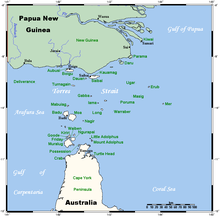Yam Island (Queensland)
|
Native name: Yama; Iama Nickname: Turtle-backed Island |
|
|---|---|

Landsat image of Yam Island
|
|

A map of the Torres Strait Islands showing Iama in the central waters of Torres Strait
|
|
| Geography | |
| Location | Tancred Passage, Northern Australia |
| Coordinates | 9°54′00″S 142°46′01″E / 9.900°S 142.767°ECoordinates: 9°54′00″S 142°46′01″E / 9.900°S 142.767°E |
| Archipelago | Bourke Isles group, Torres Strait Islands |
| Adjacent bodies of water | Torres Strait |
| Total islands | 1 |
| Area | 2 km2 (0.77 sq mi) |
| Administration | |
|
Australia
|
|
| State | Queensland |
| Local government area | Torres Strait Island Region |
| Demographics | |
| Population | 338 (2001 census) |
| Ethnic groups | Torres Strait Islanders |
Yam Island, called Yama or Iama in the Kulkalgau Ya language or Turtle-backed Island in English, is an island of the Bourke Isles group of the Torres Strait Islands, located in the Tancred Passage of the Torres Strait in Queensland, Australia. The island is situated approximately 100 kilometres (62 mi) northeast of Thursday Island and measures about 2 square kilometres (0.77 sq mi).
Its indigenous language is Kulkalgau Ya, a dialect of the Western-Central Torres Strait language, Kalaw Lagaw Ya. The population of Yam was 338 as at the 2001 census.
Yam Island has interesting prehistory records in local legends in Papua and Torres Strait.
According to Mabuiag-Badu legend, Austronesian people from far-east Papua settled on Parema in the Fly Delta and married local trans-Fly women (of the group of peoples now called Gizra, Wipi, Bine, Meriam). Later they moved down to Torres Strait and settled on Yama, and then spread from there to different island groups. Westwards they went to Moa, Mabuiag, and there fought with local Aboriginal people and married some of the women, though apparently ‘purists’ who wanted to avoid further mixture moved north to Saibai, Boigu and Dauan. These initial settlements could have been anything up to around 2800 years ago. Eastwards they settled all the Central and Eastern Islands. They did not seem to have gone south to the Muralag group at this time. Much later, the Trans-Fly Meriam people of Papua moved to Mer, Erub and Ugar, taking most of the original inhabitants' land. These people, Western-Central Islanders, they called the Nog Le Common People, as opposed to the Meriam People, who are the noble people. Western-central Islanders in general are called the Gam Le Body People, as they are more thick-set on the whole than the slender Meriam.
This was the establishment of the Islanders as we know them today. Their languages are the mix of cultures mentioned above: the Western-Central language is an Australian (Paman) language with Austronesian and Papuan elements as cultural overlays, and the Eastern Language is dominantly Papuan, though with significant Australian and Austronesian elements.
...
Wikipedia
